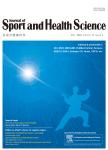Overweight and obesity in young adults with patellofemoral pain:Impact on functional capacity and strength
作者机构:Department of PhysiotherapySchool of Science and TechnologySao Paulo State University(UNESP)Presidente Prudente19060-900Brazil La Trobe Sport and Exercise Medicine Research CentreSchool of Allied HealthHuman Services and SportLa Trobe UniversityMelbourneVIC 3086Australia
出 版 物:《Journal of Sport and Health Science》 (运动与健康科学(英文))
年 卷 期:2023年第12卷第2期
页 面:202-211页
核心收录:
学科分类:0403[教育学-体育学] 1002[医学-临床医学] 1010[医学-医学技术(可授医学、理学学位)] 10[医学]
主 题:Body fat distribution Body mass index Patellofemoral pain syndrome Torque
摘 要:Purpose:This study aimed to(a)investigate the proportion of overweight/obesity in a cohort of young adults with patellofemoral pain(PFP)and(b)explore the association of body mass index(BMI),body fat,and lean mass with functional capacity and hip and knee strength in people with PFP.Methods:We included a mixed-sex sample of young adults(18-35 years old)with PFP(n=100).Measurements for BMI,percentage of body fat,and lean mass(assessed by bioelectrical impedance)were obtained.Functional capacity was assessed by the Anterior Knee Pain Scale,plank test,and single-leg hop test.Strength of the knee extensors,knee flexors,and hip abductors was evaluated isometrically using an isokinetic dynamometer.The proportion of overweight/obesity was calculated based on BMI.The association between BMI,body fat,and lean mass and functional capacity and strength was investigated using partial correlations,followed by hierarchical regression analysis,adjusted for covariates(sex,bilateral pain,and current pain level).Results:A total of 38%of our cohort had their BMI categorized as overweight/obese.Higher BMI was associated with poor functional capacity(ΔR^(2)=0.06-0.12,p0.001)and with knee flexion strength only(ΔR^(2)=0.04,p=0.030).Higher body fat was associated with poor functional capacity(ΔR^(2)=0.05-0.15,p≤0.015)and reduced strength(ΔR^(2)=0.15-0.23,p0.001).Lower lean mass was associated with poor functional capacity(ΔR^(2)=0.04-0.13,p≤0.032)and reduced strength(ΔR^(2)=0.29-0.31,p0.001).Conclusion:BMI,body fat,and lean mass should be considered in the assessment and management of young people with PFP because it may be detrimental to function and strength.



